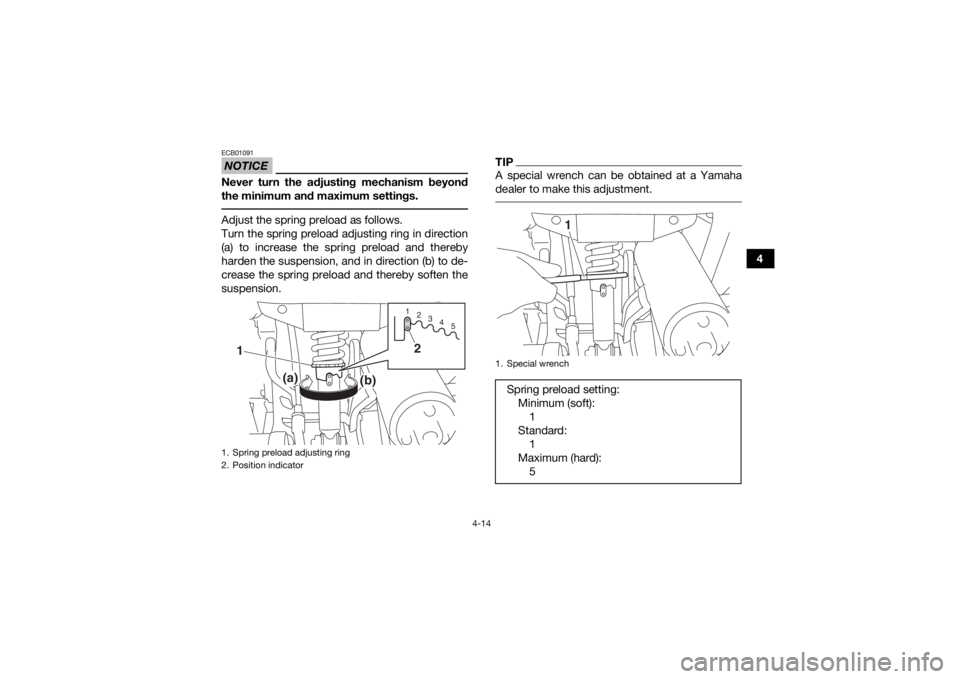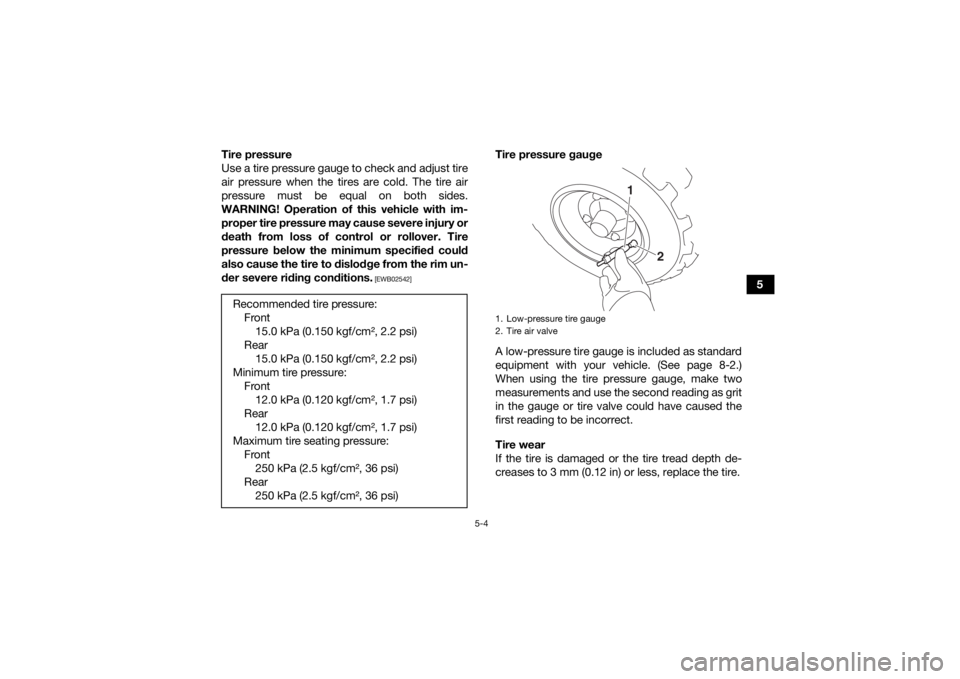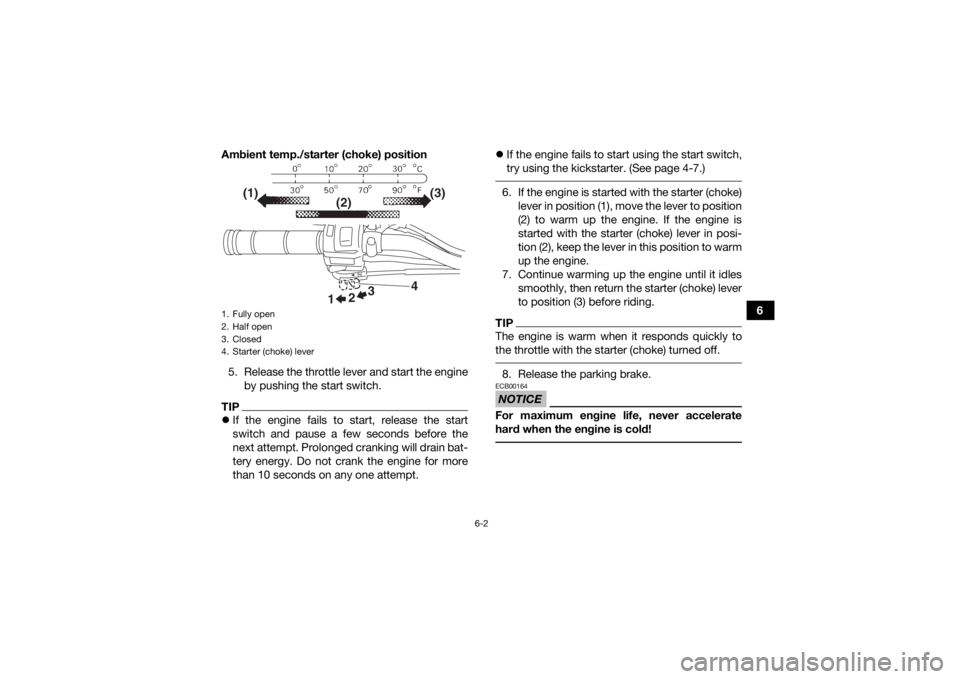YAMAHA YFZ50 2020 Service Manual
Manufacturer: YAMAHA, Model Year: 2020, Model line: YFZ50, Model: YAMAHA YFZ50 2020Pages: 126, PDF Size: 5.44 MB
Page 41 of 126

4-14
4
NOTICEECB01091Never turn the adjusting mechanism beyond
the minimum and maximum settings. Adjust the spring preload as follows.
Turn the spring preload adjusting ring in direction
(a) to increase the spring preload and thereby
harden the suspension, and in direction (b) to de-
crease the spring preload and thereby soften the
suspension.
TIPA special wrench can be obtained at a Yamaha
dealer to make this adjustment.
1. Spring preload adjusting ring
2. Position indicator
1234 52
1
(a)
(b)
1. Special wrenchSpring preload setting:
Minimum (soft):1
Standard: 1
Maximum (hard): 5
1
UBW463E0.book Page 14 Monday, January 28, 2019 10:22 AM
Page 42 of 126

5-1
5
EBU19203
PRE-OPERATION CHECKS
EBU19226Inspect your vehicle each time you use it to make sure the vehicle is in safe operating condition. Always
follow the inspection and maintenance procedures and schedules described in the Owner’s Manual.
WARNING
EWB00482Failure to inspect or maintain the vehicle properly increases the possibility of an accident or equip-
ment damage. Do not operate the vehicle if you find any problem. If a problem cannot be corrected
by the procedures provided in this manual, have the vehicle inspected by a Yamaha dealer. Before using this vehicle, check the following points:
ITEMROUTINE PAGE
Fuel • Check fuel level in fuel tank,
and add recommended fuel if neces-
sary.
• Check fuel line for leakage. Correct if necessary. 4-9, 5-3
Engine oil • Check oil level in engine, and add recommended oil to specified
level if necessary.
• Check ATV for oil leakage. Correct if necessary. 5-3, 8-11
Transmission oil • Check ATV for oil leakage. Correct if necessary. 5-3, 8-15
Front brake • Check operation, and correct if necessary.
• Lubricate cable if necessary.
• Check lever free play, and adjust if necessary. 5-3, 8-23, 8-24
Rear brake • Check operation, and correct if necessary.
• Lubricate cable if necessary.
• Check lever free play, and adjust if necessary. 5-3, 8-23, 8-26
UBW463E0.book Page 1 Monday, January 28, 2019 10:22 AM
Page 43 of 126

5-2
5
Throttle lever• Make sure that operation is smooth. Lubricate cable and lever
housing if necessary.
• Check lever free play, and adjust if necessary. 5-3, 8-22
Control cables • Make sure that operation is smooth. Lubricate if necessary. 8-29
Drive chain • Check chain slack, and adjust if necessary.
• Check chain condition. Lubricate if necessary. 5-3, 8-26, 8-29
Wheels and tires • Check wheel condition, and replace if damaged.
• Check tire condition and tread depth. Replace if necessary.
• Check air pressure. Correct if necessary. 5-3
Brake levers • Make sure that operation is smooth. Lubricate lever pivoting points
if necessary. 8-30
Chassis fasteners • Make sure that all nuts, bolts and screws are properly tightened. 5-6
Instruments and switches • Check operation, and correct if necessary. 5-6
ITEM ROUTINE PAGE
UBW463E0.book Page 2 Monday, January 28, 2019 10:22 AM
Page 44 of 126

5-3
5
EBU38000FuelMake sure there is sufficient gasoline in the tank
before starting off. Refuel if necessary. (See page
4-9.)EBU19561Engine oilMake sure that the engine oil is at the specified
level. Add oil as necessary. (See page 8-11.)EBU34490Transmission oilMake sure that the transmission oil is at the spec-
ified level. Add oil as necessary. (See page 8-15.)EBU19653Front and rear brakesBrake levers
Check for correct free play in the brake levers. If
the free play is incorrect, adjust it. (See pages
8-24 and 8-26.)
Check operation of the levers. They should
move smoothly and there should be a firm feel-
ing when the brake is applied. If not, have the
ATV checked by a Yamaha dealer. Brake operation
Test the brakes at slow speed after starting out to
make sure they are working properly. If the brakes
do not provide proper braking performance,
check the brake shoes for wear. (See page 8-23.)
EBU19762Throttle leverCheck the operation of the throttle lever. It must
open smoothly and spring back to the idle position
when released. Have a Yamaha dealer correct if
necessary.EBU19771Drive chainCheck the condition of the drive chain and check
the drive chain slack. Lubricate and adjust the
drive chain as necessary. (See page 8-26.)EBU19799TiresCheck tire pressure regularly to make sure it is at
the recommended specifications. Also check for
wear and damage.
UBW463E0.book Page 3 Monday, January 28, 2019 10:22 AM
Page 45 of 126

5-4
5
Tire pressure
Use a tire pressure gauge to check and adjust tire
air pressure when the tires are cold. The tire air
pressure must be equal on both sides.
WARNING! Operation of this vehicle with im- proper tire pressure may cause severe injury or
death from loss of control or rollover. Tire
pressure below the minimum specified could
also cause the tire to dislodge from the rim un-
der severe riding conditions.
[EWB02542]
Tire pressure gauge
A low-pressure tire gauge is included as standard
equipment with your vehicle. (See page 8-2.)
When using the tire pressure gauge, make two
measurements and use the second reading as grit
in the gauge or tire valve could have caused the
first reading to be incorrect.
Tire wear
If the tire is damaged or the tire tread depth de-
creases to 3 mm (0.12 in) or less, replace the tire.
Recommended tire pressure:
Front15.0 kPa (0.150 kgf/cm², 2.2 psi)
Rear 15.0 kPa (0.150 kgf/cm², 2.2 psi)
Minimum tire pressure: Front12.0 kPa (0.120 kgf/cm², 1.7 psi)
Rear 12.0 kPa (0.120 kgf/cm², 1.7 psi)
Maximum tire seating pressure: Front250 kPa (2.5 kgf/cm², 36 psi)
Rear 250 kPa (2.5 kgf/cm², 36 psi)1. Low-pressure tire gauge
2. Tire air valve
1
2
UBW463E0.book Page 4 Monday, January 28, 2019 10:22 AM
Page 46 of 126

5-5
5Tire information
This ATV is equipped with tubeless tires and tire
air valves. After extensive tests, only the tires list-
ed below are approved for this model by Yamaha. Aftermarket tires and rims
The tires and rims that came with your ATV were
designed to match the performance capabilities
and to provide the best combination of handling,
braking, and comfort. Other tires, rims, sizes, and
combinations may not be appropriate.
WARNING
EWB02552Use of improper tires on this ATV may cause
loss of control, increasing your risk of an acci-
dent.
1. Tire tread depth
Front:
Manufacturer/model:DURO/DI2040
Size: AT 1 6 x 6 . 5 - 7
Rear: Manufacturer/model:DURO/DI2041
Size: AT 1 6 x 7 - 7
UBW463E0.book Page 5 Monday, January 28, 2019 10:22 AM
Page 47 of 126

5-6
5
EBU19841Chassis fastenersMake sure that all nuts, bolts and screws are
properly tightened.EBU33810Instruments and switchesCheck that all instruments and switches are work-
ing properly. Correct if necessary.UBW463E0.book Page 6 Monday, January 28, 2019 10:22 AM
Page 48 of 126

6-1
6
EBU19882
OPERATION
EBU19902Read the Owner’s Manual carefully before riding
the ATV. If there is a control or function you do not
understand, ask your Yamaha dealer.
WARNING
EWB00632Read the Owner’s Manual carefully to become
familiar with all controls in order to help pre-
vent any loss of control, which could cause an
accident or injury. EBU36361Starting a cold engineNOTICEECB00151See the “Engine break-in” section on page 6-3
prior to operating the engine for the first time. 1. Set the parking brake. (The engine can bestarted only when the rear brake lever is ap-
plied.)
2. Turn the fuel cock to “ON”. 3. Turn the key to “ON” and set the engine stop
switch to “ ”.
4. Position the starter (choke) lever according to the ambient temperature.
Position (1):
Cold engine start with ambient temperature
below 5 °C (40 °F).
Position (2):
Cold engine start with ambient temperature
between 0 °C (30 °F) and 30 °C (90 °F).
Position (3):
Cold engine start with ambient temperature
above 25 °C (80 °F).
UBW463E0.book Page 1 Monday, January 28, 2019 10:22 AM
Page 49 of 126

6-2
6
Ambient temp./starter (choke) position
5. Release the throttle lever and start the engine by pushing the start switch.
TIPIf the engine fails to start, release the start
switch and pause a few seconds before the
next attempt. Prolonged cranking will drain bat-
tery energy. Do not crank the engine for more
than 10 seconds on any one attempt.
If the engine fails to start using the start switch,
try using the kickstarter. (See page 4-7.)
6. If the engine is started with the starter (choke)
lever in position (1), move the lever to position
(2) to warm up the engine. If the engine is
started with the starter (choke) lever in posi-
tion (2), keep the lever in this position to warm
up the engine.
7. Continue warming up the engine until it idles smoothly, then return the starter (choke) lever
to position (3) before riding.TIPThe engine is warm when it responds quickly to
the throttle with the starter (choke) turned off. 8. Release the parking brake.NOTICEECB00164For maximum engine life, never accelerate
hard when the engine is cold!
1. Fully open
2. Half open
3. Closed
4. Starter (choke) lever
4
3
2
1
(1) (3)
(2)
UBW463E0.book Page 2 Monday, January 28, 2019 10:22 AM
Page 50 of 126

6-3
6
EBU20292Starting a warm engineFollow the same procedure as for starting a cold
engine, with the exception that the starter (choke)
is not required when the engine is warm. Instead,
start the engine with the throttle slightly open.EBU36861Engine break-inThere is never a more important period in the life
of your engine than the first 240 km (150 mi) or 20
hours of operation. For this reason, you should fol-
low the engine break-in instructions carefully.
Since the engine is brand new, do not put an ex-
cessive load on it for the first 240 km (150 mi) or
20 hours. During this period the various parts in
the engine wear and polish themselves to the cor-
rect operating clearances. Avoid prolonged full-
throttle operation or any condition that might re-
sult in engine overheating.
0–120 km (0–75 mi) or 0–10 hours
Avoid prolonged operation above 1/2 throttle.
Vary the speed of the ATV regularly. Do not oper-
ate it at one set throttle position.120–240 km (75–150 mi) or 10–20 hours
Avoid prolonged operation above 3/4 throttle. Rev
the engine freely, but do not use full throttle at any
time.
240 km (150 mi) or 20 hours and beyond
The ATV can now be operated normally.
NOTICEECB00221If any engine trouble should occur during the
engine break-in period, immediately have a
Yamaha dealer check the ATV. EBU36370ParkingWhen parking the ATV, apply the rear brake lever,
stop the engine, apply the parking brake, and then
turn the fuel cock to “OFF”.
UBW463E0.book Page 3 Monday, January 28, 2019 10:22 AM